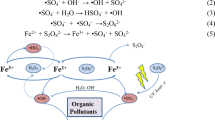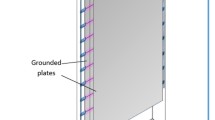Abstract
The gliding electric discharge in humid air is a source of activated species forming (e.g. •OH, •NO and their derivatives H2O2, ONO2H and NO3H) which are present in a non-thermal plasma at atmospheric pressure. These species are able to degrade organic pollutants in palm oil refinery wastewaters (PORW). The increase in acidity (pH decrease), conductivity and total dissolved solids (TDS) and the decrease in the total organic carbon (TOC) of PORW samples exposed to the discharge are reported. More than 50 % TOC abatement is obtained for 15 min treatment in batch conditions with a laboratory reactor. The organic pollutants of PORW, i.e. mainly fatty acids are degraded according to a pseudo first-order reaction (k* = 0.06 min−1). Post discharge reactions are also observed after having switched off the discharge, which suggests that the pseudo first-order (k ≈ 0.05 min−1) degradation reactions should be attributed to the diffusion of soluble reactive species, e.g. H2O2 and ONOOH in the liquid target.








Similar content being viewed by others
References
Balazy, M. (1994). Peroxynitrite and arachidonic acid. Identification of arachidonate epoxides. Polish Journal of Pharmacology, 46, 593–600.
Benstaali, B., Moussa, D., Addou, A., & Brisset, J.-L. (1998). Plasma treatment of aqueous solutes: some chemical properties of a gliding arc in humid air. European Physical Journal Applied Physics, 4, 171–179.
Benstaali, B., Boubert, P., Cheron, B., Addou, A., & Brisset, J.-L. (2002). Density and rotational temperatures measurements of the ·NO and ·OH radicals produced by a gliding arc inhumid air and their interaction with aqueous solutions. Plasma Chemistry and Plasma Processing, 22, 553–571.
Bonnefont-Rousselot D., Beaudeux J. L., & Delattre J. (2005). Radicaux Libres et Stress Oxydant. Lavoisier Eds. Paris France, ch.6, pp.147–167.
Botti, H., Batthyany, C., Trostchansky, A., Radi, R., Freeman, B. A., & Rubbo, H. (2004). Peroxynitrite-mediated α-tocopherol oxidation in low-density lipoprotein: a mechanistic approach. Free Radical Biology & Medicine, 36, 152–162.
Brisset, J.-L., & Hnatiuc, E. (2012). Peroxynitrite: a re-examination of the chemical properties of non-thermal discharges in humid air over aqueous solutions. Plasma Chemistry and Plasma Processing, 32, 655–674. doi:10.1007/s11090-012-9384x.
Brisset, J.-L., Lelièvre, J., Doubla, A., & Amouroux, J. (1990). Interaction with aqueous solutions of the air corona products. Rev Phys Appl, 25, 535–543.
Brisset, J.-L., Moussa, D., Doubla, A., Hnatiuc, E., Hnatiuc, B., Kamgang Youbi, G., Herry, J.-M., Naitali, M., & Bellon-Fontaine, M.-N. (2008). Chemical reactivity of discharges and temporal post-discharges in plasma treatment of aqueous media. Example of gliding discharge treated solutions. A review. Industrial and Engineering Chemistry Research, 47, 5761–5781.
Brisset, J.-L., Benstaali, B., Moussa, D., Fanmoe, J., & Njoyim-Tamungang, E. (2011). Acidity control of plasma-chemical oxidation: applications to dye removal, urban waste abatement and microbial inactivation. Plasma Sources Science and Technology (Special issue), 20, 034021.
Briviba K., Klotz L.-O., & Sies H. (1999) Defenses against peroxynitrite. In: L. Packer (Ed). Nitric Oxide, Part C. New York :Academic Press. Chap 32, pp 301–311.
Cicheli, A., & Solinas, M. (1984). Phenolic compounds of olives and olive oil. Riv Merceol, 23, 55–56.
Czernichowski, A. (1992). Gliding discharge reactor for H2S valorisation or destruction. In: B. Penetrante & S, Schultheis (eds). "Non-thermal Plasma Techniques for Pollution Control". Nato ASI Series G34 B: 371–387.
Czernichowski, A. (1994). Gliding arc: applications to engineering and environment control. Pure and Applied Chemistry, 66, 1301–1310.
Doubla, A. & Brisset, J.-L. (2006). Post-discharge kinetics associated with a plasmachemical nucleophilic substitution and application to the analysis of plasma activated CO. Journal of Applied Electrochemistry, 36, 77–85.
Doubla, A., Bouba Bello, L., Fotso, M., & Brisset, J.-L. (2008). Plasma chemical decolourisation of bromothymol blue by gliding electric discharge at atmospheric pressure. Dyes Pig, 77, 118–124.
Fanmoe, J., Kamgan, J. O., Moussa, D., & Brisset, J. L. (2003). Application de l’arc glissant d’air humide au traitement des solvents industriels: cas du 1, 1,1-trichloroéthane. Phys Chem News, 14, 1–4.
Gnokam Zumgang, F., Doubla A., & Brisset, J.-L. (2010). Temporal post-discharge reactions in plasma-chemical degradation of slaughterhouse effluents. Chemical Engineering Communications, 98, 483–493.
Hnatiuc, E. (2002). “Procédés electriques de mesure et de traitement des polluants” (in French), Tec & Doc, Paris.
Ikehata, K., & Gamal El-Din, M. (2005). Aqueous pesticide degradation by ozonation and ozone-based advanced oxidation processes. A review. Ozone sci Technol, 27, 173–202.
Indarto, A., Choi, J.-W., Lee, H., Song, H. K., & Coowanitwong, N. (2006). Discharge characteristics of a gliding arc plasma in chlorinated methans diluted in atmospheric air. Plasma device Oper, 14, 15–26.
Kamgang Youbi, G., Briandet, R., Herry, J.-M., Brisset, J.-L., & Naitali, M. (2007). Destruction of planktonic, adherent and biofilm cells of Staphylococcus epidermidis using gliding discharge in humid air. Journal of Applied Microbiology, 103, 621–628.
Krawczyk, K., & Ulejczyk, B. (2003). Decomposition of chloromethanes in gliding discharges. Plasma Chemistry and Plasma Processing, 23, 265–281.
Laminsi S., Acayanka E., Teke Ndifion P., Djore Tiya A., & Brisset J.-L. (2012). Direct and post discharge chemical reactions of Fe(II) complexes in non-thermal plasma Desalination and Water Treatment, 37, 38–45.
Lesueur H, Czernichowski A, & Chapelle J (1988). Dispositif de génération de plasma basse température par formation de décharges électriques glissantes. Brevet Français, No 2639172.
Locke, B. R., Sato, M., Sunka, P., Koffmann, M. R., & Chang, J. S. (2006). Electrohydraulic discharges and non-thermal plasma for water treatment. Industrial and Engineering Chemistry Research, 45, 882–905.
Masschelein W. S. (1991). “Ozone et Ozonation des Eaux” (in French), Tec & Doc, Paris.
Moussa, D., & Brisset, J.-L. (2003). Disposal of spent tributylphosphate by gliding arc plasma. Journal of Hazardous Materials, B102, 189–200.
Moussa, D., Abdelmalek, F., Benstaali, B., Addou, A., Hnatiuc, E., & Brisset, J.-L. (2005). Acidity control of the oxidation reactions induced by non-thermal plasma treatments of aqueous effluents in pollutant abatement processes. The European Physical Journal—Applied Physics, 29, 189–199.
Moussa, D., Brisset, J.-L., Hnatiuc, E., & Decobert, G. (2006). Plasmachemical destruction of trilaurylamine from nuclear laboratories of reprocessing. Industrial and Engineering Chemistry Research, 45, 23–29.
Moussa, D., Doubla, A., Kamgang Youbi, G., & Brisset, J.-L. (2007). Post-discharge long life reactive intermediates involved in the plasma-chemical degradation of an azo dye. IEEE Transactions on Plasma Science, 35, 444–453.
Moussa, D., Naitali, M., Herry, J.-M., Hnatiuc, B., & Brisset, J.-L. (2010). Reactions induced by electrical discharges in pollutant abatement and bacterial inactivation. IEEE Conf. Optim, 2010, 1329–1335.
Naitali M., Hnatiuc B., Herry J.-M., Hnatiuc E., Bellon-Fontaine M.-N., & Brisset J.-L. (2009) Decontamination of chemical and microbial targets using gliding electrical discharges. In: G. Brelles Marino (ed). Biological and environmental applications of gas discharges plasmas”. Nova Science Publisher, Hauppauge, N.Y.; chap 6.
Njoyim-Tamungang, E., Ghogomu, P., Nzali, S., Laminsi, S., Doubla, A., & Brisset, J.-L. (2009). Coupling gliding discharge treatment and catalysis by oyster shell powder for pollution abatement of surface waters. Industrial and Engineering Chemistry Research, 48, 9773–9780.
O’Donnell, V. B., Eiserich, J. P., Bloodsworth, A., Chumley, P. H., Kirk, M., & Barnes, S. (1999). Nitration of unsaturated fatty acids by nitric oxide-derived reactive species. Methods in Enzymology, 301, 454–470.
Radi, R., Beckman, J. S., Bush, K. M., & Freeman, B. A. (1991). Cytochrome c-catalyzed oxidation of organic molecules by hydrogen peroxide. Archives of Biochemistry and Biophysics, 288, 481–487.
Radi, R., Denicola, A., Alvarez, B., Ferrer-Sueta, G., & Rubbo, H. (2000). Nitric oxide biology and pathobiology. In L. J. Ignarro (Ed.), Nitric Oxide: Biology and Pathobiology (pp. 57–82). San Diego: San Diego Academic Press.
Rubbo, H., Radi, R., Trujillo, M., Telleri, R., Kalyanaraman, B., Barnes, S., Kirk, M., & Freeman, B. A. (1994). Nitric oxide regulation of superoxide and peroxynitrite-dependent lipid peroxidation. Formation of novel nitrogen-containing oxidized lipid derivatives. Journal of Biological Chemistry, 269, 26066–26075.
Rubbo, H., Trostchansky, A., & O’Donnell, V. B. (2009). Peroxynitrite-mediated lipid oxidation and nitration: mechanisms and consequences. Archives of Biochemistry and Biophysics, 484, 167–172.
Ryan, D., & Robards, K. (1998). Phenolic compounds in olives. Analyst, 123, 31–44.
Sayadi, S., Allouche, N., & Jaoua Aloui, F. (2000). Detrimental effects of high molecular-mass polyphenols on olive mill wastewaters biotreatments. Process Biochemistry, 35, 725–735.
Sekher Pannala, A., Singh, S., & Rice-Evans, C. (1999). Interaction of carotenoids ans tocopherols with peroxynitrite. In: L. Packer (ed.). Methods in Enzymology Vol. 301: Nitric Oxide, Part C. New York: Academic Press. Chap 34. pp 319–332.
Thomas A. (2002). Fats and fatty oils. Ullmann's Encyclopedia of Industrial Chemistry, Release, 6th Edition. www.foretcommunale-cameroun.org/. 2001 Normes environnementales et procédures d’inspection des installations industrielles et commerciales au Cameroun.
Author information
Authors and Affiliations
Corresponding author
Rights and permissions
About this article
Cite this article
Mountapmbeme-Kouotou, P., Laminsi, S., Acayanka, E. et al. Degradation of palm oil refinery wastewaters by non-thermal gliding arc discharge at atmospheric pressure. Environ Monit Assess 185, 5789–5800 (2013). https://doi.org/10.1007/s10661-012-2984-3
Received:
Accepted:
Published:
Issue Date:
DOI: https://doi.org/10.1007/s10661-012-2984-3




